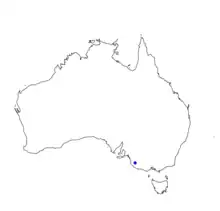Novotettix
Novotettix is a monotypic genus of cave cricket/wētā in the family Rhaphidophoridae[1] endemic to south-east Australia.[1]
| Novotettix | |
|---|---|
| Scientific classification | |
| Domain: | Eukaryota |
| Kingdom: | Animalia |
| Phylum: | Arthropoda |
| Class: | Insecta |
| Order: | Orthoptera |
| Suborder: | Ensifera |
| Family: | Rhaphidophoridae |
| Subfamily: | Macropathinae |
| Genus: | Novotettix Richards, 1966 |
| Type species | |
| Novotettix naracoortensi Richards, 1966 | |
 | |
| Geographic distribution of Novotettix | |
Taxonomy
The genus Novotettix was first described by Aola M. Richards in 1966.[2] The genus is sister to the Tasmanian genus Micropathus.[3]
Morphology
Novotettix naracootensi is adapted to living in caves. It is wingless[4] and can reach up to 18 mm (0.71 in) in length.[1] It lacks auditory tympanal organs [4] and does not make noise with its hind legs.[5] It is brown in colour, making it inconspicuous in dark caves.[4][6] Additionally, it has long antennae that extend up to five times the length of the body.[2][7]
This genus exhibits sexual dimorphism, with females being larger than males.[1] However, males have longer antennae than females.[1]
Diet
Novotettix naracootensi is an opportunistic feeder, foraging on a variety of vegetation, fungi and invertebrates, as well as on vertebrate carcasses.[2] It has also been observed exhibiting cannibalism, with adults consuming both juveniles and deceased individuals.[2]
Distribution
This genus is restricted to low-elevation limestone caves in the south-east of Southern Australia in the region of Naracoorte.[1][3] Populations can co-occur with bats[1] but numbers are lower where forest has been removed around cave entrances and/or where there is high human activity.[2]
Behaviour
Novotettix is a nocturnal subtroglophiles.[6][7][8] It exhibits a bimodal locomotor rhythm,[9] being most active around one hour after sunset.[2][9] During the evening these cave crickets move down from the roof and walls of the caves to feed on the floor and at the cave entrance.[2] Eggs are laid in the roof of the cave.[2]
References
- Richards, A. M. (1966). "The Rhaphidophoridae (Orthoptera) of Australia: A New Genus from South Australia". Proceedings of the Linnean Society of New South Wales. 91 (2): 109–111.
- Simms, R.; Lawrence, R. (1995). "Research on the Camel Cricket NOVOTETTIX naracoortensis (Richards) (ORTHOPTERA: RHAPHIDOPHORIDAE) in the Naracoorte Karst System" (PDF). Proceedings of the 20th Conference of the ASF: 39–48.
- Beasley-Hall, P. G.; Tierney, S. M.; Weinstein, P.; Austin, A. D. (2018). "A revised phylogeny of marcopathine cave crickets (Orthoptera: Rhaphidophoridae) uncovers a paraphyletic Australian fauna". Molecular Phylogenetics and Evolution. 126: 153–161. doi:10.1016/j.ympev.2018.04.024. PMID 29678644. S2CID 5021183.
- Grant, E. A. (1999). An illustrated guide to some New Zealand insect families. Manaaki Whenua Press. pp. 36–37. ISBN 0-478-09326-8.
- Williams, P. (2007). "Cave wētā". Te Ara Encyclopedia of New Zealand.
- Richards, A. M. (1968). "The Cavernicolous Status of Some Species of Macropathinae (Orthoptera: Rhaphidophoridae)". Australian Journal of Entomology. 7 (2): 87–89. doi:10.1111/j.1440-6055.1968.tb00710.x.
- Crowe, A. (2002). Which New Zealand Insect?. Penguin Books. pp. 96–99. ISBN 978-0-14-100636-9.
- Taylor, S. J. (2019). Encyclopedia of Caves (3rd ed.). Academic Press. pp. 779–783. ISBN 978-0-12-814124-3.
- Richards, A. M. (1965). "The effect of weather on Rhaphidophoridae in New Zealand and Australia". Annales de spéléologie. 20 (3): 391–400.